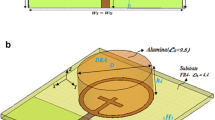Abstract
In this paper, a new four element rectangular dielectric resonator antenna (RDRA) for 5.0 GHz WLAN/WiMAX band is proposed. The simulation results for its radiation characteristics and the specific absorption rate (SAR) distribution in a homogenous bio-medium (muscle layer) for different antenna-to-muscle layer spacings are presented at different frequencies in 4.9–5.9 GHz band. The input characteristics of the proposed antenna and a single element RDRA of same size as the element are compared. The effect of changing antenna input power on maximum SAR value is also analyzed. The simulation study has been carried out using CST Microwave Studio software.











Similar content being viewed by others
References
Mongia, R. K., & Bhartia, P. (1994). DRA: A review and general design relation for resonant frequency and bandwidth. International Journal of Microwave and Millimeter Wave Computer-Aided, Engineering, 4(3), 230–247.
Ittipiboon, A., & Mongia, R. K. (1997). Theoretical and experimental investigations on rectangular dielectric resonator antennas. IEEE Transactions on Antennas and Propagation, 45(9), 1348–1356.
Rezaei, P., Hakkak, M., & Forooaghi, K. (2006). Design of wideband dielectric resonator antenna with a two segment structure. Progress in Electromagnetics Research, PIER, 66, 111–124.
Kajfez, D., & Kishk, A. A. (2002). Dielectric resonator antenna- possible candidate for adaptive antennas. In Proceedings VITEL 2002, international symposium on telecommunications, next generation networks and beyond, Portoroz, Slovenia, May 13–14.
Kishk, A. A. (2003). Dielectric resonator antenna: A candidate for radar applications. In Proceeding of 2003 IEEE radar conference (pp. 258–264). Huntsville, AL.
Saed, M., & Yadla, R. (2006). Microstrip-fed low profile and compact dielectric resonator antennas. Progress In Electromagnetics Research PIER, 56, 151–162.
Kishk, A. A., Glisson, A. W., & Zhang, X. (2002). Analysis of dielectric resonator antennas excited by a coaxial probe with wideband enhancement. In Proceeding of 2002 IEEE AP-S symposium (pp. 568–571). San Antonio, TX.
Kishk, A. A., Yin, Y., & Gilsson, A. W. (2002). Conical dielectric resonator antenna for wideband applications. IEEE Transactions on Antennas and Propagation, 50, 469–474.
Mongia, R. K., Ittipiboon, A., & Cuhaci, M. (1994). Measurement of radiation efficiency of dielectric resonator antennas. IEEE Microwave Guide Letter, 4, 80–82.
Mongia, R. K., Ittipiboon, A., Bhartia, P., & Cuhaci, M. (1993). Electric monopole antenna using a dielectric ring resonator. Electronic Letters, 29(17), 1530–1531.
Guha, D., & Antar, Y. M. M. (2006). Four-element cylindrical dielectric resonator antenna for wideband monopole-like radiation. IEEE Transactions on Antennas Propagation, 54(9), 2657–2662.
Guha, D., & Antar, Y. M. M. (2006). New half-hemispherical dielectric resonator antenna for broadband monopole-type radiation. IEEE Transactions on Antennas and Propagation, 54(12), 3621–3628.
Guha, D., Gupta, B., & Antar, Y. M. M. (2008). Quarter of a hemispherical dielectric resonator: New geometry explored to design a wideband monopole-type antenna. XXIXth URSI General Assembly. http://www.ursi.org/proceedings/procGA08/papers/BP6p1.pdf.
Okoniewski, M., & Stuchly, M. A. (1996). A study of the handset antenna and human body interaction. IEEE Transactions on Microwave Theory and, Techniques, 44(10), 1855–1864.
Pradier, A., Lautru, D., Wong, M. F., Fouad, V. H., & Wiart, J. (2005). Rigorous evolution of specific absorption rate (SAR) induced in a multilayer biological structure. Vol: 3, European microwave conference.
Gangwar, R. K., Singh, S. P., & Kumar, D. (2010). A modified fractal rectangular curve dielectric resonator antenna for WiMAX application. Progress in Electromagnetics Research C, 12, 37–51.
Chang, T.-H., & Kiang, J.-F. (2009). Sectorial-beam dielectric resonator antenna for WIMAX with bent ground plane. IEEE Transactions on Antennas and Propagation, 57(2), 563–565.
Ebrahimi-Ganjeh, M. A. (2006). Study of water bolus effect on SAR penetration depth and effective field size for local hyperthermia. Progress in Electromagnetics Research, 66, 111–124.
An Internet resource for the calculation of the dielectric properties of body tissues in the frequency range 10 Hz-100 GHz. Italian national research council, institute for applied physics. http://niremf.ifac.cnr.it/tissprop/.
Author information
Authors and Affiliations
Corresponding author
Rights and permissions
About this article
Cite this article
Gangwar, R.K., Singh, S.P. & Kumar, D. Four Element Wideband Rectangular Dielectric Resonator Antenna Terminated in a Bio-medium. Wireless Pers Commun 73, 663–677 (2013). https://doi.org/10.1007/s11277-013-1209-6
Published:
Issue Date:
DOI: https://doi.org/10.1007/s11277-013-1209-6




